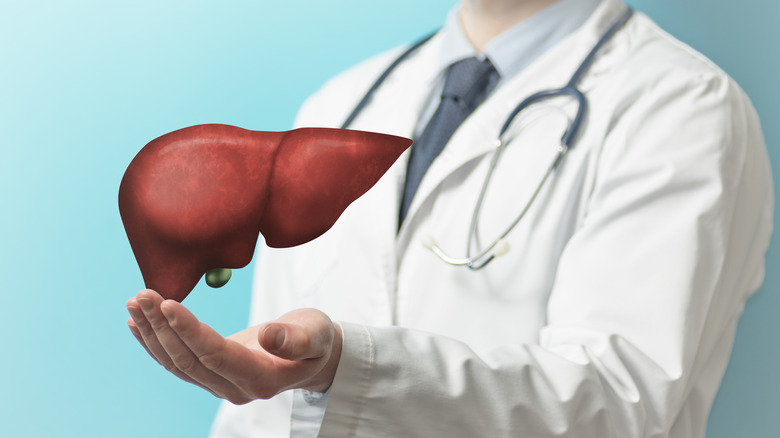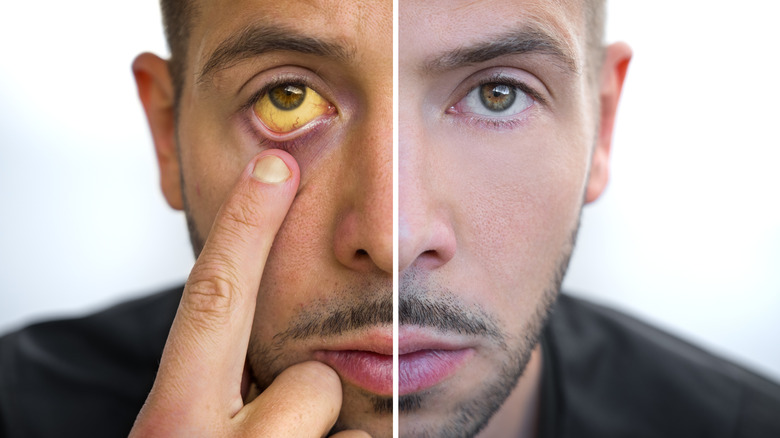Warning Signs From Your Liver That You Shouldn't Ignore
Is your liver an organ or a gland? No matter what you guessed, you're right. As the Cleveland Clinic explains, the liver is an organ that handles tasks like filtering toxins from your bloodstream and aiding in digestion. However, different medical sites, including the Cleveland Clinic, also classify the liver as a gland since it produces hormones and proteins.
Whether you want to think of it as an organ or a gland (or both), there's no denying that your liver is one of the hardest working parts of your body. Yes, it helps keep your blood clear of toxins and makes hormones, but it's also responsible for hundreds of other bodily functions, including filtering old red blood cells out of your bloodstream, helping your blood clot, making sure the right amount of blood is circulating throughout your body, and acting as a storehouse for vitamins and energy-giving glycogen.
Given everything your liver does, it's not surprising that it is not only essential for your health, but also your life. A person cannot survive without a functioning liver. And according to the Mayo Clinic, liver disease can happen for a variety of reasons like genetics, viruses, and alcohol consumption, especially if it's to excess. Here we'll explore some of the potential symptoms of liver-related health conditions to be on the lookout for. If you have any of the following symptoms, seek a diagnosis from a medical professional.
Nausea
Let's clear up some potential confusion: The condition known as hepatic adenoma is also sometimes called liver cell adenoma or hepatocellular adenoma (via Healthline). But no matter which name you or a medical professional use, it means the liver has a benign tumor. Now, there is some good news. For one, benign tumors are not cancerous. Plus, hepatic adenoma isn't a common health concern, although certain things like estrogen-based oral contraceptive pills might increase one's chances of developing it. Also, a woman who's pregnant is more likely to experience hepatic adenoma.
Even though it's not as common as other conditions on this list, it's still important to be able to recognize potential symptoms of hepatic adenoma. And this can be tricky since more often than not there are no symptoms, and even when there are, they can be mild. However, nausea and abdominal pain can both occur if a hepatic adenoma tumor has grown big enough that it's pressing against other parts of your body, like organs that are near to your liver.
While hepatic adenoma isn't cancerous, it can be dangerous (although, as Healthline explains, it's not common for it to result in a fatality). For one, an hepatic adenoma can change from being benign to being malignant (cancerous). It can also rupture, which can result in internal bleeding, a drop in blood pressure, and abdominal pain that comes on suddenly. And one more thing: A person with a hepatic adenoma tumor might need surgery to remove the tumor before it grows too large and causes other health issues.
Memory fog
Now don't panic. Of course, there are a number of simple reasons why someone might experience memory fog, or what you might refer to as brain fog. For some, thinking clearly isn't doable before that first cup of coffee. And for others, getting a lousy night's sleep means feeling like your head is in a fog for most of the day. However, as the Mayo Clinic notes, memory fog can be a warning sign of a liver-related condition called hereditary hemochromatosis.
Your body needs a certain amount of iron to function properly, but someone with hereditary hemochromatosis takes in unhealthy amounts of iron from what they consume. When this happens, the iron that the body doesn't need winds up in various organs, including the liver, which can lead to a serious disease known as cirrhosis. Unfortunately, it's possible to have hereditary hemochromatosis and not have any symptoms. With that said, a possible sign of this genetic condition is memory fog.
Even though someone is born with the genes that can cause hereditary hemochromatosis, they usually don't start exhibiting any symptoms of this condition until well into adulthood. And even then, when it occurs, symptom presentation typically varies between men (who usually don't have symptoms before 40) and women (who tend to not experience symptoms before 60). So, if you're showing this symptom — especially if you fall within this age range and/or have had a family member who's been diagnosed with hereditary hemochromatosis — you should consider reaching out to your doctor for an evaluation.
Jaundice
It's pretty common knowledge that consuming alcohol can lead to liver problems. After all, drinking alcoholic beverages to excess can result in fat accumulating in the liver, per Johns Hopkins Medicine. But a person who doesn't drink alcohol can also develop fat in their liver, which in some people can lead to liver damage. In this case, the condition is known as nonalcoholic steatohepatitis, or NASH, which is characterized by liver inflammation and injured liver cells, in addition to a buildup of fat in the organ. And while it's not that common and could take years before it progresses to the point that you have symptoms, a major potential red flag of NASH is one's eyes and/or skin becoming yellowed. Also, known as jaundice, this is a sign that the pigment that gives your blood and liver a reddish-yellow color is in higher concentrations than normal, which affects, for example, the whites of your eyes (via Cedars Sinai).
While there are ways to treat NASH like cutting out alcohol and avoiding over-the-counter (OTC) drugs whenever possible, Johns Hopkins states that there is no medication available at this time that can get rid of the accumulation of fat in a NASH-affected liver. And while the liver might be able to fix itself, the NASH could also become worse over time.
Breathing problems
Lung issues might not be the first things that come to mind when one thinks of possible warning signs regarding the liver. But keep in mind that all the parts of our bodies are connected, and as the American Lung Association points out, the liver makes a protein called Alpha-1-antitrypsin (AAT) that is important to the lungs.
While your immune system helps protect your body from microscopic threats like viruses and dangerous forms of bacteria, it can damage body tissue, including lung tissue. Fortunately, AAT helps keep your tissues safe. However, if a person is born with certain abnormal genes, their liver might make less AAT, leaving lung tissue more vulnerable to damage by the immune system. Once this happens, a person could experience wheezing and shortness of breath, per American Lung Association. They also might have chest pain that becomes worse when taking in a breath and/or coughing that involves phlegm.
The good news for someone with AAT deficiency is there are simple ways to help manage their condition. As the American Lung Association explains, regularly dusting your home can help with AAT deficiency symptoms. It's also important to avoid both smoking and breathing in secondhand smoke. However, there is a bit of bad news. At this time, there is no cure for this inherited health issue.
Abdominal pain
Even if you're not familiar with all the different types of liver diseases, there's a good chance you've heard of hepatitis. As the Centers for Disease Control and Prevention (CDC) explains, hepatitis is when the liver becomes inflamed. Now, there's more than one reason why a person might experience inflammation of the liver, so there's more than one type of hepatitis. For example, hepatitis A occurs because of a viral infection that's transmitted via another person, water or food, or even by contact with an object that's carrying the infection (per Mayo Clinic). And although not every person who has hepatitis A will experience symptoms (and some who do might not have any symptoms for weeks after initial exposure to the virus), a typical one for this condition is pain in the abdomen. Specifically, a person might feel discomfort right by where their liver is located.
Just as not everyone with hepatitis A has symptoms, not everyone will experience this condition in the same way. According to the Mayo Clinic, symptoms might disappear in a handful of weeks, or the ailment might lead to more severe health problems that last for months. If you suspect you may have hepatitis A, get to a medical professional right away.
Changes in color of waste products
Another virus that can cause inflammation in the liver is hepatitis B (HBV), per Medical News Today. Typically, infection occurs when a person comes into contact with bodily fluids that contain HBV, and those fluids get inside their body. For this reason, it's important to not share items like razors, syringes, needles, and even toothbrushes. Hepatitis B can also be transmitted through sexual activity, and some people are born with the HBV virus already in them if their mother had it while she was pregnant.
As with many other ailments on this list, it's possible for someone to have hepatitis B and not realize it. So, yes, a person with this condition might not have symptoms. However, a couple of potential telltale signs of hepatitis B involve one's urine and stool. One symptom of this type of liver infection is having dark urine (though keep in mind that other issues like dehydration can also change the color of your urine). In addition, if your stool is the same color as clay, that can also point to a hepatitis B infection. Luckily, for most people hepatitis B doesn't cause any lasting harm, but if you notice either of these symptoms, you'll want to check in with your doctor.
Problems with joints
According to Healthline, the hepatitis C virus is only transmitted through blood (so unlike Hepatitis B, it's not transmitted through other bodily fluids like saliva or semen). Like other ailments, hepatitis C can be both chronic and acute, which can make a big difference in whether or not someone experiences symptoms.
Typically, a person with acute hepatitis C either doesn't have symptoms or has only mild ones that disappear without medical intervention (via Healthline). In fact, it's possible for someone with this form of hepatitis to not experience any symptoms until twelve weeks after first being infected. But one of the symptoms that might develop is pain in their joints. On the other hand, chronic hepatitis C can involve severe symptoms that last for years. And like acute hepatitis C, the chronic version of this health problem can cause both joint and muscle pain.
Although both acute and chronic hepatitis C can affect the joints, a major difference between them is that chronic hepatitis C's symptoms won't go away without medical treatment. What's more, not addressing this form of hepatitis can result in the liver becoming scarred (a condition known as cirrhosis), the liver no longer functioning properly, and liver cancer. So it's crucial to seek medical help right away if you think you may have hepatitis C.
Loss of appetite
As Johns Hopkins Medicine points out, there is a type of liver inflammation that occurs not because of viruses invading the body, but because of the body's natural defenses. Sometimes the immune system goes after the liver's cells, which can cause the liver to become inflamed, swollen, and injured. This version of hepatitis is called autoimmune hepatitis, and it can be tricky to recognize.
Unfortunately, a big reason why someone might not realize they have this form of hepatitis is the vagueness of its symptoms. For example, a person with this condition might experience a loss of appetite, in addition to other symptoms of liver problems including jaundice, discolored urine or stool, and joint pain among others.
While aspects of autoimmune hepatitis are still unknown to us — including what causes it — there are patterns that can point to potential risk factors. For instance, women tend to develop autoimmune hepatitis more often than men. Also, certain conditions like celiac disease, type 1 diabetes, and thyroiditis might up one's chances of developing autoimmune hepatitis.
Swelling
We can't talk about liver health problems without discussing cirrhosis. According to Healthline, a person with this condition has a permanently and badly scarred liver. Most of the time when people think of this ailment, they associate it with overuse of alcohol. However, someone can also develop cirrhosis because of viruses.
Now, it's important to keep in mind that cirrhosis occurs in two stages: the less severe compensated stage, and the more severe decompensated stage, via The U.S. Department of Veterans Affairs. However, as Healthline explains, symptoms don't usually happen until a person's liver is in the decompensated stage. One possible sign of cirrhosis is a condition called edema (via National Institute of Diabetes and Digestive and Kidney Diseases or NIDDK). When this occurs, fluid builds up in different parts of one's body causing swelling, per NIDDK. In the case of cirrhosis, someone might experience this accumulation of fluid in their feet, ankles, and the lower parts of their legs.
Besides edema, a scarred liver can also cause ascites, which as WebMD notes is when there's an accumulation of fluid that causes swelling in the abdomen. And while you should seek medical help if you have any possible symptom of cirrhosis, swelling in the legs and/or abdomen are particularly serious red flags of this health problem. Fortunately, even a liver in the decompensated cirrhosis stage might be able to go back to the less severe compensated stage.
Bumps
Normally when one thinks of digesting, the focus is on stomach acid. But as the American Liver Foundation points out, the liver is also directly involved in the digestive process. Your liver makes bile, which helps break down different vitamins your body needs. It accomplishes this by sending the bile out via the bile ducts. But when a person has primary biliary cholangitis, or PBC, these ducts become damaged, so the bile accumulates inside the liver. And this can damage your liver and eventually cause severe scarring.
Since PBC takes time to develop, it's possible for someone with this liver-related health issue to not experience any symptoms. However, a potential telltale sign of PBC is xanthomas, which as Mount Sinai explains is when specific types of fat amass under the skin in areas like the knees, elbows, feet, hands, or buttocks. This results in small yellow, white, or orange bumps that sometimes develop in clusters. In fact, Mount Sinai notes that xanthomas could be an indication that someone not only has PBC, but also that their liver is becoming scarred because of it.
Besides xanthomas, a person with PBC could also develop xanthelasmas (per American Liver Foundation). When this happens, a person will have deposits of plaque on the skin, usually on the eyelids, creating yellow bulges (via Medscape). If unusual bumps begin appearing on one's skin, have them checked by a medical professional.
Fever with chills
Bile ducts are crucial not only for proper digestion, but also your liver's overall health. After all, without the bile ducts functioning properly, bile would get stuck in the liver and might cause damage, via Cedars Sinai. Unfortunately, it is possible for the bile ducts to become scarred and cause harmful bile buildup that harms the liver. This rare condition is known as primary sclerosing cholangitis, or PSC. One potential sign someone has PSC is having a fever along with chills, which is a common red flag signaling infection — in this particular case, that their bile ducts have become infected.
At this time, we're still learning about PSC. According to Cedars Sinai, there isn't a cure for this liver issue, nor can medications slow its progression. But that doesn't mean there aren't any options for someone with PSC. For instance, its possible for a healthcare professional to open up the bile ducts, which can allow bile to flow more freely.
Bruising more easily
One common red flag of damage to the liver is bruising and even bleeding more easily. This is because your liver makes proteins known as coagulation factors, which are crucial for your blood to clot properly, per Gastrointestinal Society. But when a liver is injured, it cannot make these coagulation factors in the right amount. And when this happens, your body is more likely to bruise and bleed. As Oxford University Hospitals explains, a bruise is a "soft tissue injury" that occurs when blood vessels are injured and bleed. Of course, bruises can vary in severity, but as Medical News Today points out, they disappear once the body reabsorbs the blood.
So, how can you tell if you're bruising more easily than usual? Well, according to Medical News Today, a few things to look out for are the number bruises, how long they take to heal, the size of the bruises, and whether or not they're painful. Also, if minor injuries produce major bruising, that can be a warning sign flag that something might be wrong with your liver.
Regardless if liver issues are the culprits behind bruising, there are things you can do to help your bruise heal. These include using ice packs (per Oxford University Hospitals). Just make sure to wrap the ice pack in a damp cloth before you apply it to yours or someone else's skin. And only leave an ice pack on a bruise for five to 10 minutes at a time.
Mental changes
We often think about how the brain affects other areas of the body. However, the reverse is also true. Take the disorder known as hepatic encephalopathy (HE), for example. This condition occurs when toxins accumulate in one's brain and (not surprisingly) can have a negative impact on someone mentally (via WebMD). And since the liver helps filter harmful materials from your bloodstream, liver problems like cirrhosis and hepatitis can lead a person to develop HE.
It's possible to have HE and not have severe symptoms, per WebMD. Other symptoms might include feeling cranky, being forgetful, nervousness, confusion, losing interest in things that would normally have some level of significance, and being excitable. Additionally, someone with HE might behave inappropriately through either their actions or their words. Changes in personality that seem to come suddenly out of the blue can also be major red flags of this disorder.
Although activities like drinking large amounts of alcohol can trigger HE-related health problems, so can a particular treatment sometimes used for cirrhosis patients. A medical professional might put a small tube called a shunt inside a liver with cirrhosis in order to redirect blood flow. While this can help with cirrhosis, it can also mean the liver filters fewer toxins.
Hallucinations
What's the first thing that comes to mind when you hear the word "hallucination?" Probably it's seeing something that isn't actually there. However, as MedlinePlus explains, hallucinations can affect more than just one's sense of sight, and can include such things as hearing sounds or smelling odors that aren't there. And even though hallucinations are created by the brain, they can also be red flags of problems with your liver.
According to WebMD, the disease called Reye's syndrome can lead to both the brain and the liver becoming swollen. Once this happens, a person might experience hallucinations. Someone with Reye's syndrome may also feel exhausted, experience convulsions or seizures, lose consciousness, or exhibit changes in personality. While Reye's syndrome is rare, it can occur because of a viral infection like the chickenpox or the flu (per WebMD). Exposure to products like weed killer and paint thinners can also increase one's odds of having Reye's syndrome. The disease is potentially fatal, so seek medical help right away if you even suspect you or someone you know has this condition.















